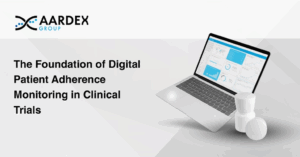Recognizing the problem: Status quo bias in adherence measurement
Among the many forces that can influence clinical trials, arguably not enough attention is paid to status quo bias.
A common phenomenon, status quo bias can explain why any proposed departure from existing expectations or dominant practice can be eyed with skepticism; it can be the reason why change is often perceived as a risk rather than an opportunity for improvement.
Nowhere can this be seen more clearly than in the area of measuring medication adherence. Here, it is widely accepted that commonly used methods for measuring adherence can be flawed, largely because trial patients can easily create a fake record of perfect adherence. However, these methods remain the most likely to be adopted by trial coordinators.
Status quo bias accepted, it remains important to question why this is the case. Why not employ more accurate measurement systems? Why not use methods where the process could be hidden from patients entirely? Why not endeavor to improve trial integrity and enhance the value of the insights derived from the process?
Electronic monitoring as a better alternative
Exploration of these points becomes even more pertinent in the knowledge that there is already an answer to the question of ‘how?’ in the form of electronic monitoring. Currently used in an estimated 2.7% of trials1, electronic monitoring is a concept first pioneered in the form of the MEMS® Cap. It has continued to evolve over decades of development and today describes a range of advanced, digitally based approaches to adherence measurement.
Digital Medication Adherence Process
In typical applications, a microchip is integrated into drug packaging. This might be a pill bottle or blister pack, but it can also potentially be used with injectables, inhalers, cream tubes and containers for eye drops. When patients complete the action required to access or administer the medication from the packaging, a discreet timestamp is generated and transmitted in real-time by the chip, creating a digital log of dosing history.
Studies have shown that while these electronically recorded dosing histories might represent a measure of active dosing intent rather than direct evidence of ingestion, they do align with bioanalytical measures in 97% of cases. This demonstrates the ability of electronic monitoring to facilitate a data-rich continuous assessment of drug exposure between visits from trial coordinators.2
Smart Pills
With a view to closing this ingestion-evidence gap entirely, electronic monitoring techniques have evolved further. An example is the ‘smart pill’, which is based on a patient-safe microcircuit being integrated within solid oral drug forms. The circuit is activated by gastric acid, triggering the generation of a weak radio signal that conveys information on the drug’s identity and the timing of ingestion. This signal is detected, amplified, and retransmitted to a more distant source via a signal-detection skin patch or necklace worn by the patient.
Smart pills are undoubtedly a highly effective means of proving ingestion, bringing significant value to focused settings such as Phase I studies. It is fair to say, however, that this particular method does face challenges when deployed at scale in terms of drug stability, patient intrusiveness and logistics.3
Smart use of smart technology: Implementation and Benefits
Sound preparation is critical to the successful implementation of electronic monitoring. This begins with selecting the appropriate device for data collection based on the requirements of the trial in question. Smart pill bottles or blisters have the capacity to generate substantial amounts of complex data related to medication adherence, and so it is important to consider how that data will be stored, managed and processed. Only then can stakeholders be assured that the resulting outputs will support the required analysis.
Where studies are correctly designed, electronically compiled adherence data achieves several key objectives:
- For patients, the processed data delivers feedback on adherence behavior, fostering engagement and helping motivate participants to contribute fully in the study.
- Investigators and study monitors can leverage the processed data to monitor patient adherence patterns, identify potential issues and make informed decisions regarding patient care.
- Sponsors, who bear the responsibility for ensuring the success of the trial, can utilize the processed data to evaluate the impact of adherence on study outcomes and adjust strategies if needed.
These points show how the data-driven approach that underpins electronic monitoring has the potential to improve both the process of adherence measurement and the findings themselves. In doing so, it can elevate the success and integrity of drug trials – and all without the knowledge of the patients who are taking part.
A Call to Action
In light of these advantages, and in an era of evidence-based medicine, it becomes increasingly difficult to justify the acknowledged disadvantages, deficiencies and drawbacks of more traditional approaches to adherence measurement in clinical trials.
Indeed, it can be argued that the current status quo almost equates to a form of omerta – an unspoken agreement between stakeholders that failures related to monitoring non-adherence among patients goes unsaid and unchallenged. Clearly, there is a need to challenge this inertia. There is a requirement for stakeholders involved in trials to accept the raw truth of the current situation and for there to be a genuine shift in mindset when it comes to tackling non-adherence among subjects.
Bringing this issue out into the open would allow light to be shed on the problem. Study staff would be in a position to discuss the difficulties associated with patient adherence in a way that happens infrequently under the current dynamic of most clinical trials. This would mark the first crucial step towards identifying approaches that can limit the risk of non-adherence and its damaging impact on trial outputs.
Enhancing Trial Integrity Through Better Adherence Data
This vision must, of course, be understood in a wider context, and the mere presence of non-adherence should not necessarily be regarded as an indicator of failure or incompetence. On the contrary, by acknowledging, identifying and addressing the issue, the industry can take a necessary step towards enhancing transparency and maintaining the highest possible levels of integrity in clinical trials.
This ‘continuous improvement’ model is an approach endorsed by the U.S. Food and Drug Administration (FDA). In its guidance on enrichment strategies for clinical trials, the FDA recommends using data on medication adherence throughout a study as a means of managing and optimizing adherence. It is effectively advocating the creation of a targeted feedback loop, incorporating risk stratification and preventive measures.
The use of more reliable methods of adherence measurement, such as electronic monitoring, has encouraged more scrutiny to be applied to the issue of medication non-adherence in drug development. As they have increased in popularity, these approaches have not only revealed the true nature of the problem but also its true extent. Put simply, if reliable methodologies are not employed for adherence measurement, study findings may be distorted, jeopardizing patient safety after the drug is approved for release to the market.
In randomized clinical trials, deviations in medication adherence typically occur after treatment initiation and impact the interpretation of the study’s outcome variable. Consequently, medication non-adherence is considered an intercurrent event, as defined by the European Medicines Agency in the ICH E9 (R1) addendum on estimands and sensitivity analysis in clinical trials.
Where more reliable methods of non-adherence measurement are employed, they provide a causal pathway between medication intake, drug exposure and treatment effects, resulting in more valuable adherence-informed analysis.
Conclusion: From Noise to Clarity
Ultimately, drug trials are based on the simple premise of accurately evaluating the safety and efficacy of new drugs. It is a model predicated on analyzing an output signal generated by an input, which in this system is defined by the dosing regimen(s) specified in the protocol. The presence of medication non-adherence in this model creates variability in exposure levels, which, if not measured correctly, translates into noise in the system, precluding appropriate estimation of the output in terms of safety and efficacy.
With relatively little change in approaches to adherence measurement over the years, trial sponsors have accepted the complication created by this noise. But why not adopt a proven, reliable and more precise methods? Why not adopt more appropriate ways of monitoring of adherence that allow this noise in the system to be deciphered into a clear – and highly valuable – signal?
Equipped with an appetite to break free from the status quo, the industry can find a simple answer to these questions in the form of electronic monitoring. It is time not just to acknowledge this technology’s future potential, but to embrace it as the platform for a more effective, patient-centric approach to medicine approval today.
References
- Mantila KM, Pasmooij AMG, Hallgreen CE, Mol PGM, van Boven JFM. Medication Adherence Measurement Methods in Registration Trials Supporting the Approval of New Medicines: A Cross-Sectional Analysis of Centralized Procedures in the European Union 2010-2020. Clin Pharmacol Ther. 2022 Nov;112(5):1051-1060. doi: 10.1002/cpt.2709. Epub 2022 Jul 30. PMID: 35816103; PMCID: PMC9795959.
- Vrijens B, Urquhart J. Methods for measuring, enhancing, and accounting for medication adherence in clinical trials. Clin Pharmacol Ther. 2014 Jun;95(6):617-26. doi: 10.1038/clpt.2014.59. Epub 2014 Mar 12. PMID: 24739446.
Eisenberger U, Wüthrich RP, Bock A, Ambühl P, Steiger J, Intondi A, Kuranoff S, Maier T, Green D, DiCarlo L, Feutren G, De Geest S. Medication adherence assessment: high accuracy of the new Ingestible Sensor System in kidney transplants. Transplantation. 2013 Aug 15;96(3):245-50. Doi: 10.1097/TP.0b013e31829b7571. PMID: 23823651; PMCID: PMC3749815.



